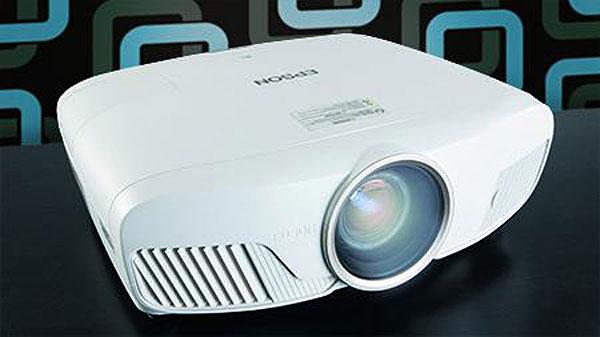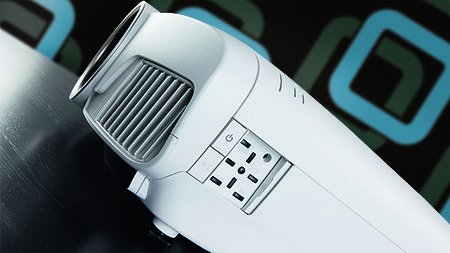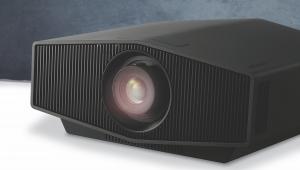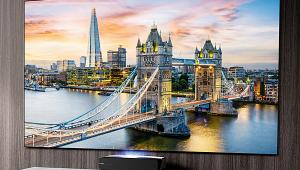Epson EH-TW7300 review


Somehow, Epson’s new EH-TW7300 only costs £2,200. That's despite it being one of only a handful of projectors capable of playing both 4K and high dynamic range sources. Surely such a ground-breaking deal has to be too good to be true?
From the outside there’s no obvious sign that the TW7300 is hiding some sort of big, nasty compromise. It sports the same enormous bodywork we saw wrapped around the higher-spec TW9300 last year, and at first glance it seems to offer the same connections – including two HDCP 2.2-enabled HDMIs, a 12V trigger port, and an RS-232C jack.
Further investigation, though, reveals that unlike the TW9300, there’s no version of this model that supports wireless HD video transmission. More important ways this PJ's specifications fall short of those of its higher-end sibling are its 2,300 Lumens of maximum light output (compared to 2,500), and its claimed dynamic contrast ratio of 160,000:1, versus an eye-popping 1,000,000:1.
These spec differences would look substantial even if we were only talking about a standard dynamic range projector. With HDR they could add up to a night-and-day performance difference. We'll see, but first some details...
The TW7300 supports active shutter 3D, while its 4K capabilities are delivered in a ‘pseudo’ fashion similar to that used by JVC’s e-Shift projectors. Essentially two sets of 1080p chipsets are placed in sequence but offset diagonally by half a pixel, resulting in double the amount of physical pixels in the finished image. This does not enable the projector to deliver a true 4K image; the projector still has to downscale 4K to HD to run through the 1080p chips. But it can certainly create an image that looks more dense, clean (provided the projector’s image processing is good enough) and free of jaggies than anything you’d get from a Full HD model.
The TW7300 supports an extensive suite of picture adjustments, including a powerful processing system containing noise reduction, frame interpolation, resolution boosting and dynamic contrast components. You can also instantly turn the majority of the processing off via a ‘Fast’ processing mode. This reduces the time the projector takes to render images to around 32ms on average, making the TW7300 a good bigscreen video gaming display.
Impressively, considering its mid-range nature, the TW7300 deploys a motorised optical zoom and vertical/horizontal image shifting system that aids initial setup, and enables Epson to offer lens memories, where you can establish different image settings for different content aspect ratios.
Magnificent scalingWith standard dynamic range the TW7300 is remarkably good for its money. Running the Ultra HD Blu-ray of The Magnificent Seven without HDR enabled reveals an image of impressive clarity and detail. The various extreme close-ups during Chisolm’s first bar-room shootout aren’t quite as textured and precise as they are on the genuine Full UHD Sony VW550ES, but they certainly look more than ‘just HD’.
Colours also appear bold during Magnificent Seven’s climactic sun and blood-drenched final sequences, but they’re detailed and natural, propelled by an impressive combination of brightness and black level response. You have to tweak a little to get the TW7300’s contrast working to its best advantage; I’d recommend setting the lamp output to low and the dynamic contrast to medium for the best results in a dark room. This is no great hardship, though, and it’s nice that the TW7300 has sufficient setup flexibility to deliver a surprisingly watchable picture even if there’s a little additional light in the room.
Motion remains clean and stable even when all the Magnificent Seven’s horses are charging across the screen, and noise is at a premium, proving the quality of Epson’s ‘4K Enhanced’ processing.
The TW7300 continues to impress with a normal HD Blu-ray of Goosebumps. The same scaling engine that does such a clever job of giving a pseudo 4K effect with 4K sources makes the sequence with the werewolf in the supermarket look more textured, natural and ‘filmic’ than it does on normal HD projectors. Even colour blends enjoy an uptick in subtlety rather than just being left looking plasticky as they would with lesser scaling engines.
Moving into the third dimension with old favourite Tangled, the TW7300 takes its first significant stumble. Initially all seems well, as Tangled’s animated environments look unusually bright, colourful and well proportioned for such an affordable projector. Unfortunately, though, large-scale shots like the early dance in the market and the later floating lantern love song sequence exhibit quite high levels of crosstalk ghosting around objects in the mid and far distance.

You might be wondering at this point why I’ve yet to mention the TW7300’s HDR performance. The answer, sadly, is that I’ve been saving the worst until last.
The problem is that the Epson doesn’t have enough brightness or contrast to dovetail with HDR’s extreme luminance range and colour volumes. In fact, it just can't make HDR as watchable as SDR.
There are four main problems with the TW7300’s HDR presentation. First, the darkness of the big fight between Batman and Superman in – yes – Batman v Superman looks too cloying in HDR thanks to the way shadow detail is crushed out of the darkest areas.
Second, dark objects can begin to silhouette if they're battling against lighter backdrops.
Third, the picture looks duller overall than it does if you watch the same scenes in standard dynamic range, as the projector lowers the image’s brightness floor in a bid to deliver an increased sense of dynamism.
Finally, if you try to push the brightness up to levels that look more, well, HDR, such as by using the Dynamic picture preset, significant amounts of detail gets clipped out of the picture’s brightest areas. Explosive effects in Batman v Superman appear bleached and empty.
The one real plus note in the TW7300’s HDR pictures is the way it renders a strikingly wide colour palette if you engage the Cinema preset, which introduces an extra physical colour filter into the optical array. Unfortunately, though, this colour filter makes HDR content look even darker.
The bottom line is that while I sincerely admire Epson’s determination to make HDR enjoyable on a mid-range model, the results are so compromised on the TW7300 that I’d suggest you just stick with SDR.
Or if you really want HDR, try to find the extra money needed to buy the somewhat more satisfying TW9300.
It hardly seems fair, though, to finish this review on such a downer. While it may not fly with HDR, that’s perhaps only to expected for the money. Far less expected is how efficient the TW7300 is when it comes to regular (albeit 2D) Blu-rays, with the impressive 4K enhancement technology proving worthy of its inclusion. As a successor to Epson's long-running EH-TW7200, this is a meaningful upgrade.
Specification
3D: Yes. Active shutter 4K: No. 'Enhanced’ from double 1080p chipset system, but will accept a 4K signal HDR: Yes. HDR 10 Connections: 2 x HDMI inputs; RS-232; 12V trigger port Brightness (claimed): 2,300 Lumens Contrast (claimed): 160,000:1 Zoom: x2.1 Dimensions: 520(w) x 170(h) x 450(d)mm Weight: 11kg
Features: LCD projector, 4K Enhancement technology; 24dB claimed running noise in Normal lamp mode; 5,000-hour claimed lamp life in economy mode; motorised lens adjustments; AMX, Crestron, Control4 support; DCI colour filter in Cinema mode; ‘Fast’ processing mode for gaming; 1.35-2.84:1 throw ratio; 10-position lens memory; frame interpolation; Super Resolution; vertical lens shift (+/- 96.3%); horizontal lens shift (47.1 %); USB input for Wireless LAN adapter (optional)
 |
Home Cinema Choice #351 is on sale now, featuring: Samsung S95D flagship OLED TV; Ascendo loudspeakers; Pioneer VSA-LX805 AV receiver; UST projector roundup; 2024’s summer movies; Conan 4K; and more
|























































